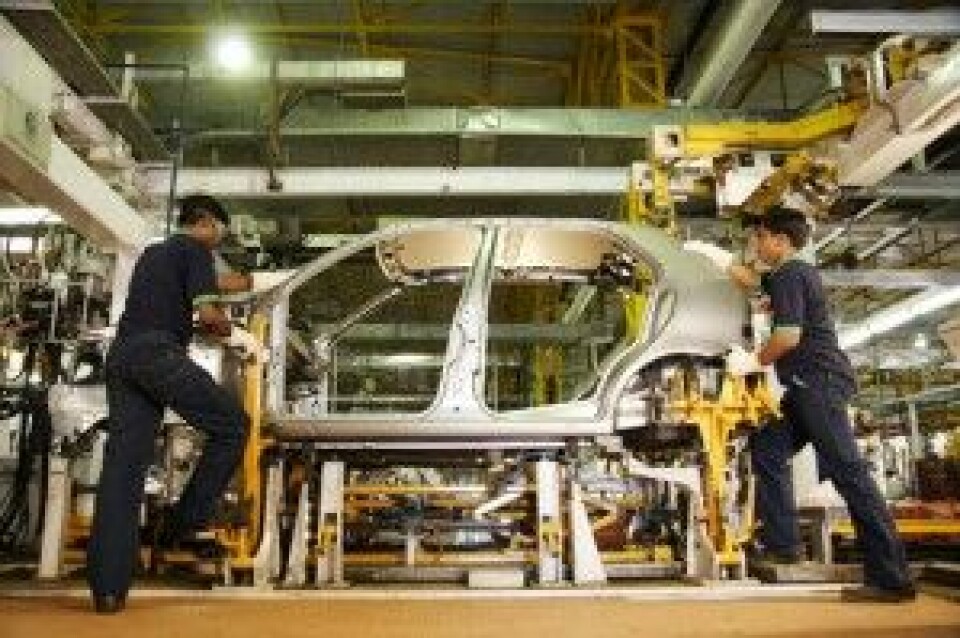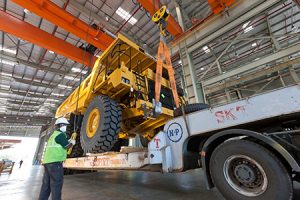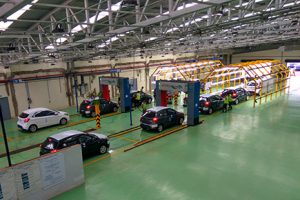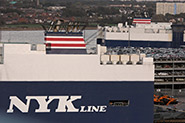Indian export logistics: Waiting for an upgrade
In this story...
India’s vehicle exports are gradually on the rise, with plenty of room to grow. However, the nation’s poor export logistics and high port costs may hold the country back
India’s big problem is a straightforward one: it does not yet have enough top-class dedicated ro-ro terminals at its ports. Simply put, the standard of the country’s exports infrastructure remains lower than that of many advanced countries and other competitors such as Thailand.
The solution, of course, is not so straightforward, but both government and industry are determined to bring down the resulting costs of logistics and their drag on economic competitiveness.
This determination is reflected in policy initiatives and infrastructure plans to make India’s automotive industry a pillar of growth and industrial exports. They range from the government’s latest Automotive Mission Plan for 2016-2026 – which aims to position the automotive industry as the engine of the ‘Make in India’ programme – to the ‘Sagarmala’ port development project to modernise the nation’s ports, which includes initiatives such as improving ro-ro facilities and encouraging modal shift to domestic coastal ro-ro shipping, inland waterways and rail freight.
Although India accounts for only a minuscule share of the global car market, the country has firmly established itself as an export hub for small cars, led by the likes of Hyundai and Suzuki. Despite economic woes in export markets in Africa and Latin America, and a global shift away from small cars in many markets, India’s vehicle exports are still rising. According to the Society of Indian Automobile Manufacturers (SIAM), the first quarter of the current financial year has seen a 12% rise in passenger vehicle exports compared to last year, at 158,782, while commercial vehicle exports rose 7% to 26,159. Annual exports are expected to approach 600,000 for passenger vehicles.

OEMs in India export to most global markets except for the US. Exports to Mexico have seen big rises of late
[sta_anchor id="1"]OEMs in India export to most global markets except for the US, although of late they have seen big rises to Mexico. “Shipping lines are using multiple routings for Mexico – via South Africa, Europe or Japan – based on cargo consolidation requirements,” says Captain Sandeep Chawla, executive director of NYK Auto Logistics India. “Hambantota in Sri Lanka is a strategic location as a trans-shipment hub and is likely to see increased volumes as exports from India expand.”
Almost half of India’s vehicle exports originate from the production cluster in the south, including from Hyundai, Renault Nissan and Ford, with the main outbound ports being Chennai and Kamarajar (Ennore) in Tamil Nadu, in the east.
Hyundai Motor India, which has two manufacturing plants in Chennai from which it distributes to more than 92 countries, has been India’s top exporter for the last ten years, although its shipments have been falling in the last three years. Exports now mainly go to Mexico, Columbia, most of Africa, the Middle East, Vietnam, the Philippines and Australia.
“Our export volumes are 150,000-160,000 cars a year, which will remain static for a couple of years because the global macroeconomic situation is still to improve,” says Venkateswaran Anand, senior general manager for sales logistics at Hyundai. “This year we do not have high hopes of an improvement.”
Maruti Suzuki, the country’s top OEM and other big exporter, has seen exports fall by 26.7% to 26,103 in the first quarter of the current financial year, in part because of a high base of sales to Sri Lanka last year and the subsequent fall in demand after the island raised import taxes. HDFC Securities, a financial services firm, expects some recovery, however, forecasting the OEM’s exports to grow around 1.8% in 2016.
[sta_anchor id="2"]East coast issuesHyundai has been a long-standing customer of the port of Chennai, having signed a memorandum of understanding in 2006, effective until 2018, under which it gets significant concessions such as wharfage refunds and priority berthing. But there are problems with the port, admits Anand.
 At the west-coast port of Mumbai, congestion due to container and breakbulk carriers can lead to restrictions on finished vehicle access
At the west-coast port of Mumbai, congestion due to container and breakbulk carriers can lead to restrictions on finished vehicle access“The main challenges relate to inland movement to the port,” he says. “Chennai port is very much accommodative of us but the logistics ecosystem does not help us a great deal. The main problems are in timing, the number of vehicle movements and access to the port.”
The port is in the heart of the city and the road from Hyundai’s factory runs through an area where government offices are located, with heavy goods vehicles only allowed along the key Poonamallee High Road from 11pm to 5am, thus limiting the number of cars Hyundai can move daily into port. Access to the port itself is also limited to one gate.
“Other than that, the port infrastructure is good enough for 90% of our shipments,” says Anand. “The draught is adequate, the area needed for storage can accommodate about 4,000 cars of different sizes – our typical shipments are 3,000-4,000 units – and if a shipment exceeds that we always get ad hoc space from the port.”
The biggest advantage for Hyundai is having space at Chennai port’s west quay, which means cars move only 500 metres to load a vessel. “That means quality is assured because there is no damage to vehicles,” explains Anand. “In most other ports, such as Mumbai or Mundra in Gujarat, cars have much longer distances to travel – sometimes over 3km.”
 "Chennai port is very much accommodative of us but the logistics ecosystem does not help us a great deal. The main problems are in timing, the number of vehicle movements and access to the port." - Venkateswaran Anand, Hyundai Motor India
"Chennai port is very much accommodative of us but the logistics ecosystem does not help us a great deal. The main problems are in timing, the number of vehicle movements and access to the port." - Venkateswaran Anand, Hyundai Motor India
Anand believes these infrastructure issues will take time to be sorted. The government is looking at an elevated corridor, he says, where consignments from the western part of Bangalore can reach Chennai directly. But the project has been delayed and could take another three to four years.
West coast issuesOEMs face similar issues at west coast ports. India’s Mahindra & Mahindra, a big player in the SUV and tractor market, faces restrictions on movements into the port of Mumbai, for example, which can get congested as it caters to container and breakbulk carriers as well as car carriers, says Chandrakant Kadam, head of international logistics at the OEM.
Vehicles are typically transported by road from its plant in Maharashtra, which is within 200km of Mumbai, and unloaded inside the port. The company exports both passenger and commercial vehicles, mainly to a range of Asian, African and Latin American countries.
In 2015, Mahindra & Mahindra saw its highest ever export volume at 36,031 passenger vehicles, up 19% from the previous year, although tractor shipments fell 16% to 11,545, mainly owing to a slowdown in the African market. Mahindra & Mahindra expects global growth to continue, however.
“We expect a 20% increase in exports, particularly in commercial vehicles where we have a strong hold in overseas markets,” says Kadam.
Mahindra exports by ro-ro vessels from Mumbai and uses the nearby JNPT (Jawaharlal Nehru Port Trust) facility for a smaller number of knockdown kits in containers. “We also use containers to export to some markets where there are no ro-ro operations, such as Africa,” explains Kadam.
The infrastructure inside Mumbai port could be improved for vehicle exports, Kadam says. Cars now have to be driven 3-4 km from the storage location to the ship’s berth, increasing the risk of damage. “And we need to transport vehicles during the night to port as there are restrictions on road movements during daytime,” he says. “Our inland logistics cost is low because we are close to the port, we get a one-month free period for storage and wharfage is minimal, but port infrastructure is not up to the mark for handling ro-ro, and we need multi-storey car parking and improvements to road conditions inside and on the approach to Mumbai port.”
Discussions on a multi-storey car park inside the port are ongoing but it does not seem likely in the short term. An alternative for M&M could be to use Pipavav port, north of Mumbai, which recently added ro-ro facilities that the company has tested. It could even shift wholly to JNPT. “But for now we’ll ship from Mumbai because it is close to our factory,” says Kadam.
[sta_anchor id="3"]Over-reliance on roadIndian vehicle manufacturers rely extensively on road haulage at the moment, a market sector that is insufficiently regulated, believes Ravinder Kumar Rustagi, manager of vehicle logistics at Honda Cars India.
“There is no clear rule defined for carrier dimensions. Also, car carriers are available but drivers are not. No driver wants his child to continue in his footsteps, so there’s a driver shortage,” Rustagi explains.
The issue of transporter dimensions is being addressed. Earlier this year the Indian government confirmed a new national 18.75-metre maximum length would be brought in along with several other requirements for trucks carrying finished vehicles from April next year. However, legislation is facing opposition at industry and state level. Meanwhile there seems no obvious solution to the problem of the driver shortage.
Elsewhere, a tax issue that has long troubled the industry will finally be resolved with the passing of the Goods and Services Tax (GST) Bill in the Rajya Sabha, India’s upper house of parliament, paving the way for it to come into force as early as April next year.
 Indian vehicle makers are hugely reliant on road transport but some believe the sector is insufficiently regulated
Indian vehicle makers are hugely reliant on road transport but some believe the sector is insufficiently regulatedAccording to Sandeep Chawla of NYK Auto Logistics India, this tax reform is likely to be a game-changer for logistics in India. “Multiple small warehouses in different states shall be replaced with large IT-enabled warehouses with a hub-and-spoke distribution model,” he predicts. “Similarly, finished vehicle dispatch patterns shall change from plant-to-dealer to hub-and-spoke from common stockyards in north, south, east and west India.”
Honda Cars is among those looking for alternatives to road. It focuses mainly on the domestic market and its share of exports is small, chiefly through the ports of Ennore and Pipavav in Gujarat. Rustagi says the industry is especially interested in rail and water in terms of reducing its reliance on road transport.
“The government is promoting alternative modes and wants to reduce car carriers on the road and shift the load to rail and water, but it will take four to five years,” he says. “We are already moving some cars by rail but you need big volumes for rail movements to be viable.”
[sta_anchor id="4"]Shifting to multimodalShifting to rail for large volumes of cars and over long distances will certainly be useful for carmakers but the benefits are not always straightforward.
Samir Kumar, director of freight marketing at the Ministry of Railways, says it is trying to encourage more vehicle transport by rail, hoping to increase from 3-5% of vehicles today to 20% over the next decade. One strategy has been through the government’s Automobile Freight Train Operator (AFTO) scheme for specialised traffic for companies to operate specialised rolling stock. Two major parties have so far joined the AFTO scheme – Maruti Suzuki and APL Logistics Vascor.
Indian Railways is also encouraging development of specialised dedicated rail auto hubs, with the first one opened near Chennai at Walajabad, says Kumar. The facility started operations in May with Hyundai Motors transporting 124 cars on specially designed wagons to Changsari in Assam. The facility, which has a custom-built ramp for loading cars into wagons, is close to the factories of many OEMs including Hyundai, Nissan and Daimler. For Hyundai, using rail to send cars to Chennai port is not necessary as the road distance is short, although the advantage will be 24-hour movements, obviating road haulage restrictions.
For Mahindra & Mahindra, there’s no rail network available readily from its factories to Mumbai port. Even if there were, it would mean double-handling – from factory railhead, by rail to the port depot, and from there to the ship. “If we have to do multiple handling, then the chances of cars getting damaged are very high,” says Chandrakant Kadam.
 The GST reform could lead to the use of larger, IT-enabled warehouses with hub-and-spoke distribution to ports such as Pipavav (pictured)
The GST reform could lead to the use of larger, IT-enabled warehouses with hub-and-spoke distribution to ports such as Pipavav (pictured)OEMs have also begun trials with coastal shipping to move vehicles from plant to market but so far there has been no great rush. Hyundai started a new short-sea coastal service for shipping vehicles from Chennai to Pipavav in the north-west in February. Meanwhile, Chennai, Mumbai and Kolkata have all announced reduced port charges to encourage OEMs to use the coastal route. However, there are concerns about the viability of the mode, given the lack of return cargo, the time and cost involved, and the need for double-handling.
Chawla of NYK Auto Logistics India is among the sceptics. “Road transportation is the cheapest mode of finished vehicle transportation in India. The total multimodal cost for coastal transportation of vehicles is 15-25% more than road transportation. Also, the total transit time between north and south by coastal ro-ro is twice that of road transportation.”
For some shipping lines calling at Indian ports, export volumes are still too small while port tariffs are too high.
“Indian port tariffs are among the highest in Asia,” confirms Captain Gur Prasad Kohli, head of the South Asia office at Wallenius Wilhelmsen Logistics. “India exports marginal amounts to many countries in Africa and South East Asia, and it is not feasible for main lines to call at Indian ports for small volumes.”
[sta_anchor id="5"]Growing outputKohli believes port capacity is not really a challenge since India’s ports can handle 1.2m vehicles per year while actual exports are around half that level. “Exports out of India are expected to be around 600,000 passenger vehicles and 50,000 commercial vehicles for the next two years, as buying markets evolve slowly,” he says. “As a carrier, you are obviously looking at economies of scale and consolidation in a hub for marginal markets.”
 "Indian port tariffs are among the highest in Asia. India exports marginal amounts to many countries in Africa and South East Asia and it is not feasible for main lines to call at Indian ports for small volumes." - Gur Prasad Kohli, Wallenius Wilhelmsen Logistics
"Indian port tariffs are among the highest in Asia. India exports marginal amounts to many countries in Africa and South East Asia and it is not feasible for main lines to call at Indian ports for small volumes." - Gur Prasad Kohli, Wallenius Wilhelmsen Logistics
He believes Hambantota port on Sri Lanka’s south coast could be particularly useful for vehicle trans-shipment, however. “Hambantota has a potential to be a consolidation port for marginal exports to Latin America, Africa, South-East Asia and Australia, and New Zealand, as it stands on a main shipping route.”
Other shipping lines have more substantial services for India. “Höegh Autoliners has a strong presence in the Indian market and it is the only carrier calling all the four major ports in India – Pipavav, Mumbai, Chennai and Ennore – on a regular basis,” says Gabriela Stojicevic, a spokesperson for the line. “Höegh Autoliners calls at India on our India-to-Europe and Middle East, India and Africa services. Occasionally we are also servicing India with our US-to-Middle East trade.”
Höegh recently loaded a record 6,300-plus units on one vessel at Mumbai’s offshore container terminal berth. Stojicevic points to scope for export growth as most global carmakers have a manufacturing presence in India.
Sandeep Chawla says NYK is working on various strategic initiatives to expand the scope of services to capture forecast growth in Indian vehicle exports, given the recent launch of the government’s latest Automotive Mission Plan and its target of making India one of the top three countries in the world for engineering, manufacturing and export of vehicles.
“As the exports are growing, customers are increasingly looking for professional service providers with deep expertise and a quality mindset who can provide a one-stop solution across the entire finished vehicle export service value chain,” he says.
 NYK recently opened a new joint-venture vehicle terminal with APM at the port of Pipavav
NYK recently opened a new joint-venture vehicle terminal with APM at the port of PipavavRecent developments for NYK include the opening of a joint-venture vehicle terminal with APM at the port of Pipavav, which was launched in 2015 after four years of work. The terminal is equipped with a fully functional PDI facility, customs-bonded area, a trained workforce and uses NYK’s terminal operating system for supply chain visibility.
Still, it is difficult to meet the requirements of carmakers, including in the Pune and Chennai clusters. “Road connectivity to Mumbai, Chennai and Ennore port is a major bottleneck,” he says. “Indian port tariffs for ro-ro vessels are also one of the highest in the world. Multiple handlings, poor asset utilisation, inadequate terminal infrastructure, cumbersome customs clearance process and high port tariffs have resulted in a high cost of logistics from Indian ports.
“We would like to see improved port and road infrastructure, a simplified customs process and Indian port tariffs benchmarked with other ports in South and South-East Asia,” concludes Chawla. Not so simple, after all.
India's ongoing infrastructure issues will be among the topics discussed at this year's Automotive Logistics India conference which takes place from November 8th to 10th in Gurgaon.






